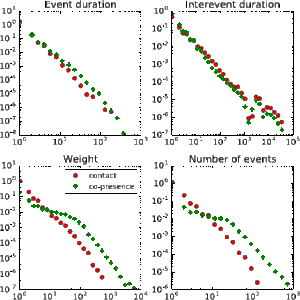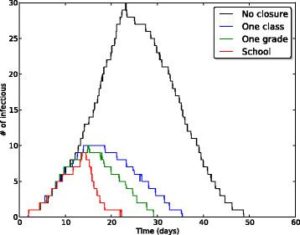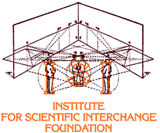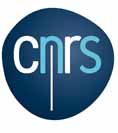DEPLOYMENT: ISI Offices
Improved contact sensing platformThe contact sensing technology used in our first pilot study during the SocioPhysics workshop suffered from two deficiencies. The first is that the fingerprint based proximity inference method was not sufficiently accurate to attain the desired spatial resolution. But more importantly it became clear that co-location is not a sufficiently reliable proxy observable of non-technologically-mediated person-to-person interactions (henceforth called NTM interactions). Co-location is a pre-condition for NTM interaction (ignoring long-range interactions involving shouting, facial expressions and/or some form of sign language), but co-location does not imply such interaction. We took two measures to address these deficiencies. The first builds on the assumption that a temporarily sustained situation in which persons face each other while being near each other, typically involves social interaction. We should thus be able to obtain more reliable proxy observables of NTM interactions by additionally detecting face-to-face orientation. The second measure was to move from proximity inference to direct proximity detection. We achieved these objectives by developing new badge firmware. The resulting new badge behavior involved the regular emission of two kinds of messages: proximity detection messages, which were emitted at a number of low power levels, and proximity reporting messages, which were emitted at the highest power level. The badges also operated in a receiving mode. The messages are thus no longer only received by the readers, but also by other badges within range. The badges were programmed to ignore the high-powered reporting messages they received, yet kept track of the number of low-powered proximity detection messages they received and to include these numbers in their reporting messages (as far as the capacity permitted). 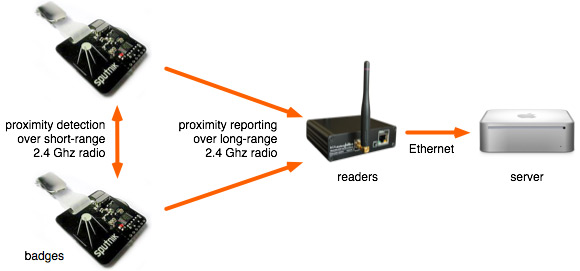 Signal flow consisting of proximity detection messages over short-range 2.4 Ghz radio between the badges, proximity reporting messages from the badges over long-range 2.4 Ghz radio to the readers, and then over Ethernet to the server. The key in achieving the direct proximity detection is that the range in which proximity detection messages can be received and subsequently reported, is dependent on the power level at which they are emitted. The approximate range for each of the four possible power levels under average atmospheric conditions are ~.5 meters; ~1.5–2 meters; ~5–8 meters; and ~15–25 meters. The key in achieving face-to-face proximity detection is that when the badges are worn on the breast like regular conference badges, then the (water in) the body shields the low-powered radio signals going backwards, as well as those coming from that direction. Low-powered proximity detection messages can thus only be exchanged between badges (and subsequently reported) when the persons wearing those badges are facing each other while being near each other. The resulting system is thus capable of directly detecting face-to-face spatial proximity of badge wearing participants, which serves as a sufficiently reliable proxy observable for non-technologically mediated person-to-person interactions, with a satisfactory spatial (~ 1 m) and temporal (~ 10 s) resolution. We call this system the SocioPatterns sensing platform. Note that since this platform does not rely on the reception of the beacon signals by multiple readers, it can be deployed with significantly less readers than its precursor. The only requirement is that all reporting messages, which are broadcast at the highest power level, can be received by at least one reader. Proof of concept deploymentIn order to test the new sensing platform we conducted a 10-day deployment at the offices of the ISI Foundation. About 45 participants, resident as well as visiting scientists, were asked to carry their badges while being present at the ISI offices. This rather small-scale deployment at our offices allowed us to interactively fine-tune the parameters and assert the accuracy of the detection and aggregation processes as well as stability of the platform over long-term deployments. Acknowledgements
|
NEWSNew data sets published: co-presence and face-to-face contactsThrough a publication in EPJ Data Science, we have released several new data sets of different types. These datasets can be found on Zenodo. On the one hand, we have released new temporally resolved data on face-to-face interactions collected in
In addition, we release data sets describing the temporally resolved co-location of individuals, where co-location of two individuals at time t means that the same exact set of readers have received signals from both individuals at time t. Data can be found on our website or on Zenodo. Obviously, the co-location data corresponds to a coarser spatial resolution than the face-to-face data, and we have compared the corresponding data in terms of structure and when used in data-driven simulations of disease propagation models in our paper.
SocioPatterns: measuring animal proximity networksAfter so many measurements concerning humans in different contexts (which we will continue measuring), SocioPatterns has partnered with different institutions to measure proximity networks of animals, ranging from free-roaming dogs to sheep and cows. The goals of the studies range from the study of social networks of animals to the development of better models of disease transmission in animal groups.
School closures to mitigate influenza spread: two studies based on SocioPatterns dataIn order to fight and mitigate emerging epidemics, non-pharmaceutical interventions can become necessary. Among these, school closure is typically regarded as a viable mitigation strategy: children indeed are known to play an important role in the propagation of infectious diseases, due to their high rate of contacts at school. School closure is however a costly measure whose applicability remains uncertain and whose implementation should carefully be weighed on the basis of cost-benefit considerations. In two successive studies published in BMC Infectious Diseases, we have used high resolution data on the contact patterns of children that we collected in a primary school,(i) to define and investigate alternative, less costly mitigation measures such as the targeted and reactive closure of single classes whenever symptomatic children are detected, at the scale of a single school and (ii) to evaluate the effectiveness of several such gradual reactive school closure strategies at the scale of entire municipalities. Our results highlight a potential beneficial effect of reactive gradual school closure policies in mitigating influenza spread. Moreover, the suggested strategies are solely based on routinely collected and easily accessible data (such as student absenteeism irrespective) and thus they appear to be applicable in real world situations. References: Mitigation of infectious disease at school: targeted class closure vs school closure
SUPPORTED BY
|
![SocioPatterns [logo]](http://www.sociopatterns.org/wp-content/themes/sp2/images/header_logo.png)
